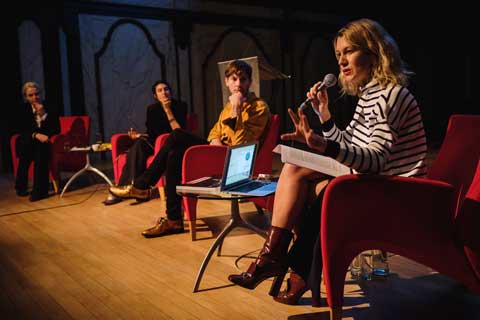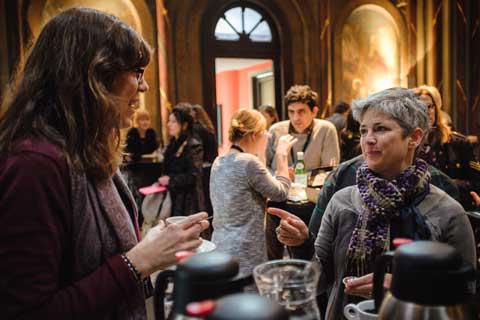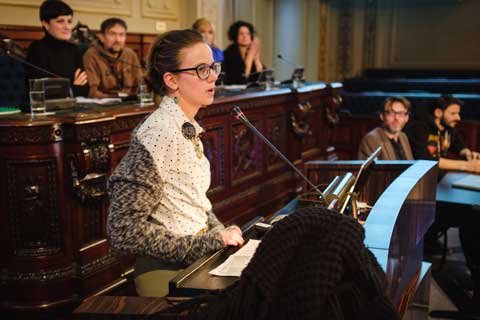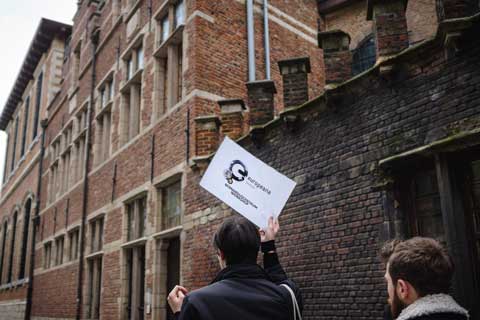Digital Fashion Futures

MoMu's Gabriëlle de Pooter showcases the Europeana Fashion Tumblr. Photo credit: CC BY-SA Erwin Verbruggen.
Over 200 participants gathered this week for the Digital Fashion Futures conference. The location: AMUZ, an Antwerp church-turned-into concert venue, kept at a slightly uncomfortable 16 degrees in order to preserve its astounding baroque oil paintings.
A Report on the Third Europeana Fashion Conference
After public gatherings in both Florence and London, this was the third and final conference from Europeana Fashion. The project started in 2012 to compel museums with fashion collections to step up their digital game and bring their collections online via a shared portal. Its consortium features a varied and extensive group of museums, collectors, brands and photographers from 12 countries.
Sound & Vision participated in the Europeana Fashion project with three goals. Firstly, we make a selection of fashion-related materials from our collections available on the portal - for a taste, see a selection of early Amsterdam fashion shows on Europeana Fashion’s Tumblr. Secondly, we performed a system evaluation of the technical toolset the project used. It took a considerable effort to reconclile, enrich and publish the more than 700.000 fashion-related photographs, drawings, documents and videos online and link them to Europeana. Finally, we set up a successful series of GLAM-Wiki collaborations - collaborations between cultural institutions (GLAM stands for galleries, libraries, archives and museums) and the wonderful world of Wikipedia. Across Europe, we've been organizing twelve Fashion Edit-a-thons, during which fashion experts learned about the joys and pitfalls of sharing knowledge about fashion on the world’s free encyclopedia.
 Natalie Joos on the Future of the Fashion Entrepreneur. Photo credit: CC BY-SA Erwin Verbruggen.
Natalie Joos on the Future of the Fashion Entrepreneur. Photo credit: CC BY-SA Erwin Verbruggen.
The Digital in Today's Fashion Domain
Professionals from all walks of life have been turned upside down by the surge of digital publishing, digital creation, mobile access and today's sharing culture. Making the most of these changes is at the core of Sound & Vision's R&D department's activities. As could be expected, the fashion domain - be it the cult of the supermodel, high-end designers, or studious academics who explore how fashion follows or shapes cultural tendencies - has not been left untouched.
Panellist Mauro Ianizzi compared "the digital" to electricity, not to be spoken of as a separate entity, but pervasive and all around us. The session on Digital Fashion and Academia talked at length about the challenges for academics who want to research evolutions in the fashion domain. Websites with reviews or collection images disappear more rapidly than one can read them. Marco Pecorari mentioned the wonderful Internet Archive and how it has helped him make sense of fashion writing over the past decade. He stressed that digital scholars need to figure out web archiving and solutions for safekeping online information.
Marketa Uhlirova, who organises the Fashion in Film festival in London, took a closer look at audiovisual archives and even talked about the wonders of nitrate film - how the emulsion, like textiles and fabrics, has its own sensory quality that is no longer present in digital formats. Nostalgia is no stranger, even to a domain as forward-looking as fashion.
 FIT's Tamsen Young in the foyer of AMUZ. Photo credit: CC BY-SA Erwin Verbruggen.
FIT's Tamsen Young in the foyer of AMUZ. Photo credit: CC BY-SA Erwin Verbruggen.
Geeks and Digital Fashion
The tension between geekdom and the grandeur of the fashion world was a recurring topic. Ykje Wildenborg, who led the Centraal Museum’s efforts in the Europeana Fashion project, pointed out how her fellow colleagues had started considering her more and more of a geek after the project incentivized her to dive deep into the world of thesauri, mapping tools, linked data and knowledge frameworks. The edit-a-thons we held were considerably held up by the same dichotomy - and even some of the presenters on stage underlined the difference - in considering the world of fashion bloggers a completely different realm from that of the more studious academic approaches to fashion culture.
One panel, on the future of digital publishing, seemed to abhor to a certain extent the limited attention span of the digital reader and manifestly preferred the tactile possibilities of print. A more interesting overview, in my regard, arose in the sessions by Tamsen Young and Anna Wright. Young, Digital Media & Strategic Initiatives Manager at the Fashion Institute of Technology ’s museum, gave an insightful overview of the choices the museum made in its digital approaches. She echoed some of the more innovative outcomes of the recent Europeana Tech conference, of innovators such as the Cooper Hewitt and digital strategists at the Tate museum: Making full and innovative use of widely used platforms such as Wordpress, as well as innovative thinking about digital exhibitions. Wright, editor at Bloomsbury publishing, performed a broad market research on the kind of offer that Berg Fashion Library or public initiatives such as Europeana Fashion have to offer to educators and users around the globe. Their soon to be launched Fashion Photography Archive is a membership programme with a wide selection of curated and uncurated photography that goes back for decades.
 Ykje Wildenborg from Centraal Museum Utrecht presenting at the workshop Using the Europeana Fashion platform. Photo credit: CC BY-SA Erwin Verbruggen.
Ykje Wildenborg from Centraal Museum Utrecht presenting at the workshop Using the Europeana Fashion platform. Photo credit: CC BY-SA Erwin Verbruggen.
A digital divide remained present in the involvement of the digital in fashion shows. Digital designer Jacob Kok showed how virtual reality helmets could make attendance at catwalk shows a virtual reality for everyone. Yet in the preceding panel, organized by the Dutch initiative ModeMuze, Jonathan Chippindale from Holition remarked that the digital possibilities, while seemingly inviting for all those outside the exclusive event to peek inside, reinforces the divide of those invited and those kept at arm’s length. While a virtual reality helmet may help you imagine sitting front-row next to Vogue’s Anna Wintour, it doesn’t exactly allow you to engage in a conversation with her.
Giving Credit Where Credit is Due
At a parallel location, the 19th century hall where the province of Antwerp makes some of its council decisions, a panel on copyright issues in the fashion domain took place. It showcased the steps made in the Europeana Fashion project (a handbook on managing IPR for publishing content online), in the wider Europeana network (the content reuse framework) and in Europe at large. In a territory with conflicting approaches to “harmonisation”, explained CMS DeBacker’s Alexis Hallemans, every country has its own understanding of certain rules, which makes publishing on an international scale a careful balancing act depending on where you publish from. Stefano Caneva from the recently instated Wikimedia Belgium carefully explained the organisation’s approach to open licenses and how to use them.
All in all, the event comprised an inspiring couple of days, a warm group of people with whom we’ve set up excellent working relationships over the three years of working together, and close-to-luxurious side events such as the visit to the wonderful exhibit on Antwerp designer Dries van Noten and toying with MoMu's massive touch screen for visitors and passers-by.
Europeana Fashion Futures
We look forward to further engage with this excellent selection of fashion museums and archives from established brands from all over Europe in the future, as members of the newly instated Europeana Fashion International Association.
Europeana Fashion is continuing its edit-a-thon series - the next dates are March 26th at the Nordiska Museet in Stockholm, in partnership with Wikimedia Sweden, and March 27th at the Amsterdam Museum, in partnership with ModeMuze and Wikimedia Netherlands. You're of course warmly invited.
 On our way to the workshop locations. Photo credit: CC BY-SA Erwin Verbruggen.
On our way to the workshop locations. Photo credit: CC BY-SA Erwin Verbruggen.
More info
- See the Europeana Fashion project page
- Press release of the Europeana Fashion kick-off [NL]
- Previous blog reports on the Europeana Fashion project
- Visit the Europeana Fashion portal to browse the collections
